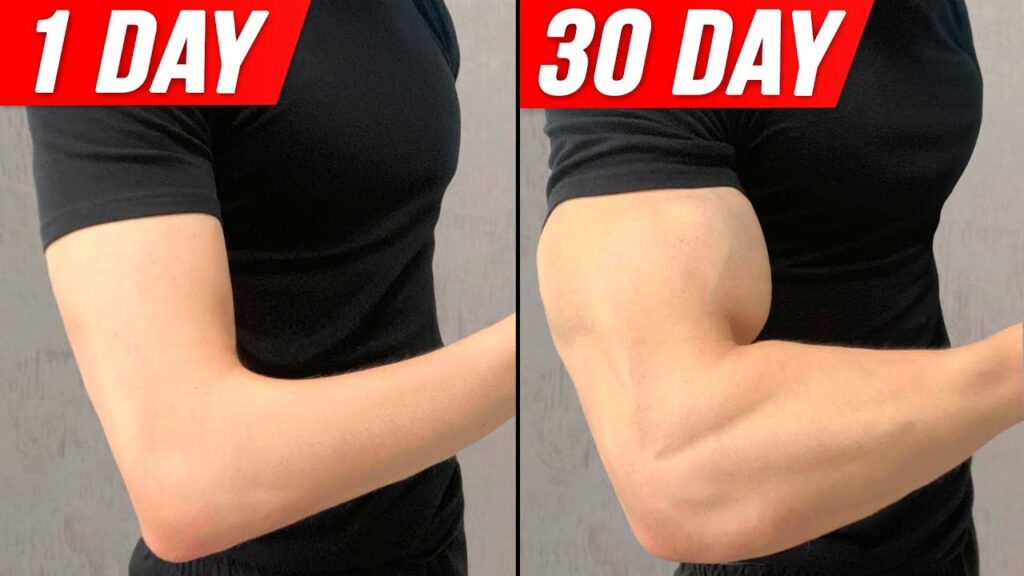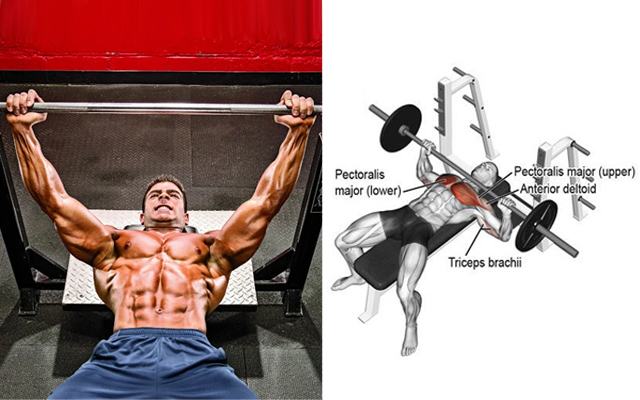Imagine standing in front of the mirror, flexing your arms, and noticing the distinct peaks and valleys of your biceps. You’ve been working hard, but something seems off. Despite your efforts, your biceps lack the fullness and definition you desire. This is a common scenario for many fitness enthusiasts, and the secret to unlocking those impressive biceps lies in understanding the anatomy of the muscle itself.
Meet Roman, a dedicated gym-goer who faced the same challenge. Roman spent hours lifting weights, yet his biceps never seemed to reach their full potential. Frustrated but determined, he decided to dive deeper into the science of muscle building. Through research and guidance from fitness experts, Roman discovered the importance of targeting both the long head and short head of the biceps.
This revelation transformed Roman’s workout routine. By incorporating specific exercises that focused on each part of the biceps, he began to see remarkable changes. His biceps grew not only in size but also in shape, giving him the well-rounded, defined look he had always wanted.
SHOP FOR THE ADJUSTABLE DUMBBELL SET ON AMAZON
In this article, we’ll take you on a journey similar to Roman’s. We’ll explore the anatomy of the biceps, the differences between the long head and short head, and the best exercises to target each part. Whether you’re a beginner or an experienced lifter, this guide will provide you with the knowledge and tools to achieve those impressive biceps you’ve been striving for.
Bicep Anatomy
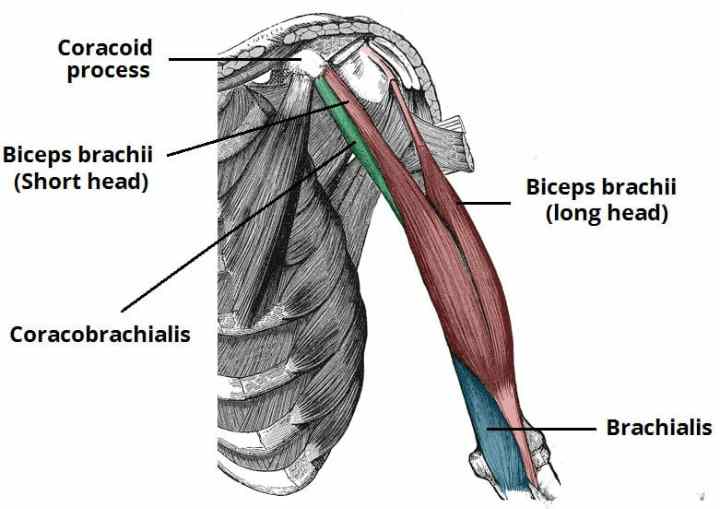
When we think of impressive arms, the biceps often steal the spotlight. But did you know that your biceps are more complex than they might appear? Understanding their anatomy can help you tailor your workouts for better results.
The biceps brachii, commonly known as the biceps, is a two-headed muscle located on the front of the upper arm. These two heads are the long head and the short head, each playing a crucial role in arm movement and muscle definition.
The Long Head
The long head of the biceps runs along the outer side of the arm. It originates from the supraglenoid tubercle of the scapula (shoulder blade) and travels down the arm, inserting into the radial tuberosity of the forearm. This head is responsible for the biceps’ peak, giving that coveted “bump” when you flex your arm. It also aids in shoulder stabilization and contributes to arm flexion and supination (rotating the palm upwards).
The Short Head
The short head lies on the inner side of the arm. It originates from the coracoid process of the scapula and also inserts into the radial tuberosity. While it might not contribute as much to the peak of the biceps, it plays a significant role in adding thickness to the muscle. The short head assists in arm flexion and helps with movements like bringing the arm across the body.
SHOP FOR THE WEIGHT PLATES ON AMAZON
Understanding these two heads is essential for effective training. Targeting both ensures balanced muscle development, enhancing not only the appearance of your arms but also their functional strength.
Importance of Targeting Both Heads
Targeting both the long head and short head of the biceps is essential for achieving balanced and well-defined arm muscles. When you work both heads, you ensure symmetrical muscle development, which prevents imbalances that could lead to uneven growth and potential injuries.
This balanced approach not only enhances the aesthetics of your biceps, giving them a more impressive and defined look, but also improves overall strength and functionality. By focusing on both heads, you enhance the comprehensive strength of your biceps, which is beneficial for various upper body exercises and daily activities that involve elbow flexion and forearm supination.
Moreover, targeting both heads maximizes muscle gains by ensuring all parts of the biceps are effectively stimulated, leading to better muscle activation and growth. This approach also adds variety to your workouts, keeping them interesting and challenging.
Balanced muscle development helps distribute the load more evenly across the biceps, reducing the risk of strain and overuse injuries, and contributes to better joint stability, particularly in the shoulder and elbow. This stability can help prevent injuries during other exercises.
SHOP FOR THE ADJUSTABLE WEIGHT BENCH ON AMAZON
Additionally, focusing on both the long head and short head enhances muscle definition. The long head contributes to the peak of the biceps, while the short head adds to the overall thickness, resulting in a more sculpted appearance. Exercises that target both heads ensure you are working the biceps through their full range of motion, leading to optimal muscle growth.
Exercises for the Long Head of the Bicep
The long head of the bicep is responsible for that peak in your bicep when you flex. Here are some key exercises to target the long head:
1. Incline Dumbbell Curls
Incline dumbbell curls are excellent for emphasizing the long head due to the stretch position they put your biceps in.
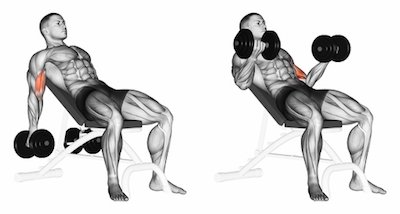
How to Perform:
- Sit on an incline bench set at a 45-degree angle.
- Hold a dumbbell in each hand with your arms fully extended and palms facing forward.
- Curl the weights up while keeping your upper arms stationary.
- Squeeze your biceps at the top of the movement, then slowly lower the weights back to the starting position.
Tips:
- Keep your elbows close to your body throughout the exercise.
- Avoid using momentum; focus on a slow and controlled movement.
- Sets: 3-4 sets
- Reps: 8-12 reps per set
- Rest: 60-90 seconds between sets
2. Drag Curls
Drag curls change the movement pattern to put more stress on the long head.
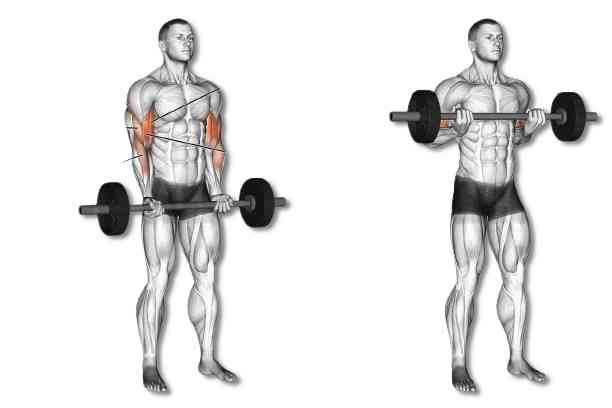
How to Perform:
- Stand with your feet shoulder-width apart and hold a barbell with an underhand grip.
- Start the curl by pulling your elbows back as you lift the barbell, keeping it close to your body.
- Drag the barbell up along your torso until it reaches your chest.
- Squeeze your biceps at the top, then slowly lower the bar back to the starting position.
Tips:
- Focus on pulling your elbows back rather than lifting the barbell.
- Maintain a controlled motion without swinging your body.
- Sets: 3-4 sets
- Reps: 8-12 reps per set
- Rest: 60-90 seconds between sets
3. Concentration Curls
Concentration curls isolate the bicep and are effective for emphasizing the long head.
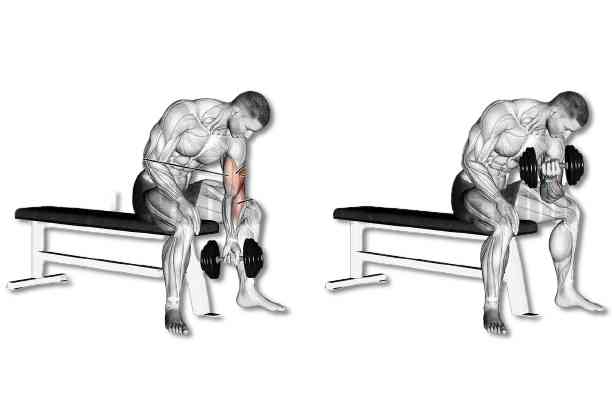
How to Perform:
- Sit on a bench and lean forward slightly, holding a dumbbell in one hand.
- Rest your elbow on the inside of your thigh with your arm fully extended.
- Curl the dumbbell up to your shoulder while keeping your upper arm stationary.
- Squeeze your biceps at the top, then slowly lower the weight back to the starting position.
Tips:
- Ensure full extension at the bottom of the movement for a complete stretch.
- Perform the exercise slowly to maximize muscle engagement.
- Sets: 3-4 sets
- Reps: 10-15 reps per set (each arm)
- Rest: 60-75 seconds between sets
4. Standing Cable Curls
Using cables allows for constant tension on the biceps, which can help target the long head effectively.
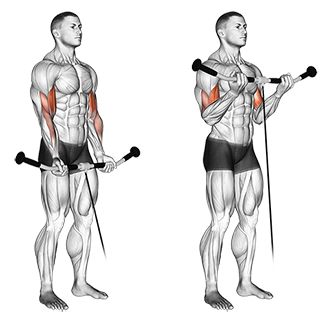
How to Perform:
- Attach a straight bar to a low pulley on a cable machine.
- Stand facing the machine and grab the bar with an underhand grip.
- Curl the bar up towards your chest while keeping your elbows close to your sides.
- Squeeze your biceps at the top, then slowly lower the bar back to the starting position.
Tips:
- Keep your back straight and avoid using your body to lift the weight.
- Focus on a smooth and controlled motion throughout the exercise.
- Sets: 3-4 sets
- Reps: 10-15 reps per set
- Rest: 60-75 seconds between sets
5. Chin-Ups
Chin-ups are a compound exercise that can heavily involve the long head of the biceps.

How to Perform:
- Grab a pull-up bar with an underhand grip, hands shoulder-width apart.
- Hang fully extended, then pull yourself up until your chin is above the bar.
- Squeeze your biceps at the top, then slowly lower yourself back down.
Tips:
- Avoid swinging or kipping to complete the movement.
- Keep your body straight and control the descent.
- Sets: 3 sets
- Reps: As many reps as possible (aim for 6-12 reps)
- Rest: 90-120 seconds between sets
Incorporating these exercises into your workout routine can help you effectively target the long head of your biceps, leading to better muscle development and a more defined arm.
Exercises for the Short Head of the Bicep
To effectively target the short head of the biceps, it’s important to incorporate exercises that emphasize the inner part of the muscle. Here are some of the best exercises to help you achieve fuller and more balanced biceps:
1. Preacher Curls
Preacher curls are excellent for isolating the short head of the biceps.

How to Perform:
- Sit on a preacher bench and hold a barbell or dumbbells with an underhand grip.
- Rest your upper arms on the bench pad.
- Curl the weight up towards your shoulders, squeezing your biceps at the top.
- Slowly lower the weight back to the starting position.
Tips:
- Keep your upper arms stationary and avoid using your shoulders.
- Focus on a slow and controlled motion to maximize muscle engagement.
- Sets: 3-4 sets
- Reps: 8-12 reps per set
- Rest Intervals: 60-90 seconds between sets
2. Spider Curls
Spider curls also emphasize the short head due to the angle of the lift.

Comparing Rack Pulls and Deadlifts
How to Perform:
- Lay face down on an incline bench, letting your arms hang down.
- Hold a barbell or dumbbells with an underhand grip.
- Curl the weight up towards your shoulders, maintaining a controlled movement.
- Lower the weight back to the starting position slowly.
Tips:
- Keep your elbows stationary to ensure the short head is fully engaged.
- Use a lighter weight to maintain proper form and avoid swinging.
- Sets: 3 sets
- Reps: 10-15 reps per set
- Rest Intervals: 45-60 seconds between sets
3. Concentration Curls
This exercise isolates each arm and targets the short head effectively.

How to Perform:
- Sit on a bench with your legs spread apart.
- Hold a dumbbell in one hand and rest your elbow on the inside of your thigh.
- Curl the dumbbell towards your shoulder, squeezing your bicep at the top.
- Slowly lower the weight back to the starting position.
Tips:
- Avoid using your body to lift the weight; focus on using your bicep.
- Perform the movement slowly to maximize tension on the muscle.
- Sets: 3-4 sets (per arm)
- Reps: 8-12 reps per set
- Rest Intervals: 60-75 seconds between sets (per arm)
4. High Cable Curls
High cable curls allow for continuous tension throughout the movement, hitting the short head effectively.
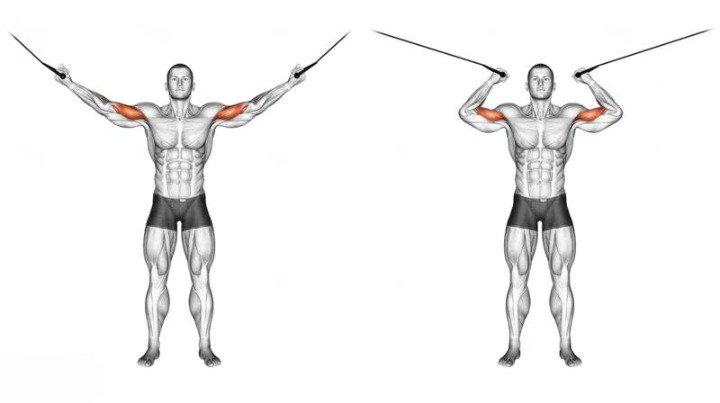
How to Perform:
- Attach handles to the high pulley of a cable machine.
- Stand in the middle and grab the handles with an underhand grip.
- Curl the handles towards your shoulders, keeping your elbows up and in line with your shoulders.
- Slowly extend your arms back to the starting position.
Tips:
- Keep a slight bend in your elbows at the starting position to maintain tension.
- Control the movement and avoid using momentum.
- Sets: 3 sets
- Reps: 12-15 reps per set
- Rest Intervals: 45-60 seconds between sets
5. Close-Grip Barbell Curls
Using a close grip on the barbell shifts more emphasis to the short head.

How to Perform:
- Stand holding a barbell with a close underhand grip (about shoulder-width apart).
- Curl the barbell up towards your shoulders, focusing on squeezing your biceps.
- Slowly lower the barbell back to the starting position.
Tips:
- Keep your elbows close to your body and avoid swinging.
- Use a controlled tempo to ensure maximum muscle activation.
- Sets: 3-4 sets
- Reps: 8-12 reps per set
- Rest Intervals: 60-90 seconds between sets
These exercises will help target the short head of the biceps, contributing to a fuller, more balanced arm development.
Common Mistakes to Avoid
When working on the long head and short head, avoiding common mistakes can significantly enhance your results and prevent injuries. Here are some frequent errors that should be avoided:
1. Neglecting One Head Over the Other: One of the most common mistakes is focusing too much on the long or short head, leading to imbalanced development. For a well-rounded bicep, it’s essential to incorporate exercises targeting both heads.
2. Using Incorrect Form: Poor form reduces the effectiveness of the exercise and increases the risk of injury. Common form mistakes include:
- Swinging the weights
- Using too much momentum
- Not fully extending or contracting the bicep
3. Lifting Too Heavy: While lifting heavy can help build muscle, using weights that are too heavy can compromise form and lead to injuries. It’s better to use a manageable weight and perform exercises with proper form to effectively target the biceps.
4. Overtraining: Overtraining the biceps can lead to fatigue, soreness, and potential injury. Biceps are involved in many upper body exercises, so it’s important to give them adequate rest. Aim for 48 hours of rest between bicep-focused workouts.
5. Neglecting Other Muscle Groups: Focusing solely on the biceps and neglecting other muscle groups can lead to muscle imbalances and a disproportionate physique. Ensure your workout routine is well-rounded and includes exercises for all major muscle groups.
6. Lack of Variation: Doing the same exercises repeatedly can lead to a plateau in progress. Incorporate a variety of exercises that target both the long head and short head from different angles to continually challenge your muscles.
7. Ignoring Stretching and Warm-Up: Skipping warm-up and stretching can increase the risk of injury. Properly warming up prepares your muscles for the workout, and stretching helps maintain flexibility and muscle health.
8. Inadequate Nutrition and Hydration: Muscle growth and recovery depend heavily on proper nutrition and hydration. Ensure you’re consuming enough protein, healthy fats, and carbohydrates, and staying hydrated to support your workouts and muscle recovery.
SHOP FOR THE EZ CURL BAR ON AMAZON
By avoiding these common mistakes, you can ensure your bicep training is effective, safe, and balanced, leading to better overall muscle development.
Advanced Techniques and Variations
Incorporating advanced techniques and variations can help to further challenge the muscles and promote growth. Here are some suggestions:
- Supersets: This involves performing two exercises back-to-back with no rest in between. For example, you could do a set of hammer curls (which primarily work the long head) immediately followed by a set of preacher curls (which primarily work the short head).
- Drop Sets: Start with a heavier weight that you can lift for 6-8 reps. Once you reach failure, immediately drop to a lighter weight and continue to perform reps until you reach failure again.
- Negative Reps: Focus on the eccentric (lowering) phase of the movement. For example, take 3-5 seconds to lower the weight in a bicep curl. This causes more muscle damage and can lead to greater growth.
- Partial Reps: Perform reps in only a portion of the full range of motion. You could do half reps at the top or bottom of the movement, or 21s (7 reps in the lower range of motion, 7 reps in the upper range, and 7 full reps).
- Grip Variations: Changing your grip can target different parts of the muscle. For example, using a wide grip on barbell curls can target the short head, while a close grip targets the long head.
- Isometric Holds: Hold the weight in a contracted position (like the top of a curl) for an extended period of time. This increases time under tension, a key driver of muscle growth.
Best Exercises to Burn Belly Fat
Remember, these advanced techniques should be used sparingly and not all at once. It’s important to listen to your body and give it ample time to rest and recover.
FAQs
Q 1. How often should I train my biceps to see results?
Ans. It’s generally recommended to train your biceps 2-3 times per week, allowing at least 48 hours of rest between sessions to ensure proper recovery and muscle growth.
Q 2. Can I target the long head and short head of the biceps in the same workout?
Ans. Yes, you can target both heads in the same workout by incorporating a variety of exercises that emphasize each part. For example, you can start with exercises that target the long head and finish with those that focus on the short head.
Q 3. How can I avoid plateauing in my biceps training?
Ans. To avoid plateaus, regularly change your workout routine by varying the exercises, adjusting the number of sets and reps, and incorporating different training techniques such as supersets, drop sets, and tempo variations.
Q 4. Is it necessary to use heavy weights to build biceps?
Ans. While lifting heavy weights can help build muscle, it’s also important to focus on proper form and muscle contraction. Using moderate weights with higher reps and maintaining good form can be equally effective for muscle growth.
Q 5. How does diet impact bicep growth?
Ans. A balanced diet rich in protein, healthy fats, and carbohydrates is essential for muscle growth. Protein is particularly important for repairing and building muscle tissue after workouts.
Q 6. Can I train my biceps if I have elbow pain?
Ans. If you experience elbow pain, it’s important to consult with a healthcare professional before continuing your training. They can provide guidance on safe exercises and modifications to avoid further injury.
Q 7. What role does genetics play in bicep development?
Ans. Genetics can influence the shape and size of your biceps, as well as how quickly you gain muscle. However, with consistent training and proper nutrition, you can still achieve significant improvements regardless of your genetic predisposition.
Q 8. How long does it take to see noticeable changes in bicep size?
Ans. The time it takes to see noticeable changes can vary based on factors like training intensity, diet, and individual genetics. Generally, with consistent training and proper nutrition, you can start to see changes within 4-8 weeks.
Conclusion
In conclusion, understanding and effectively training both the long head and short head of the bicep is crucial for overall arm development and strength. By incorporating a variety of exercises that target each head, using advanced techniques and variations, and following proper nutrition and recovery protocols, you can maximize your bicep growth and performance. Remember, consistency is key in any fitness journey. It’s not about perfect workouts, but rather about making steady progress over time.

Good day, and welcome to Fitthour. My name is Shubham Vijay, and I am a certified personal trainer and nutrition coach with 6 years of experience in the fitness industry. At Fitthour, we specialize in types of training, such as strength training, cardio, or HIIT, and our mission is to help clients achieve their fitness goals and improve their overall health.

